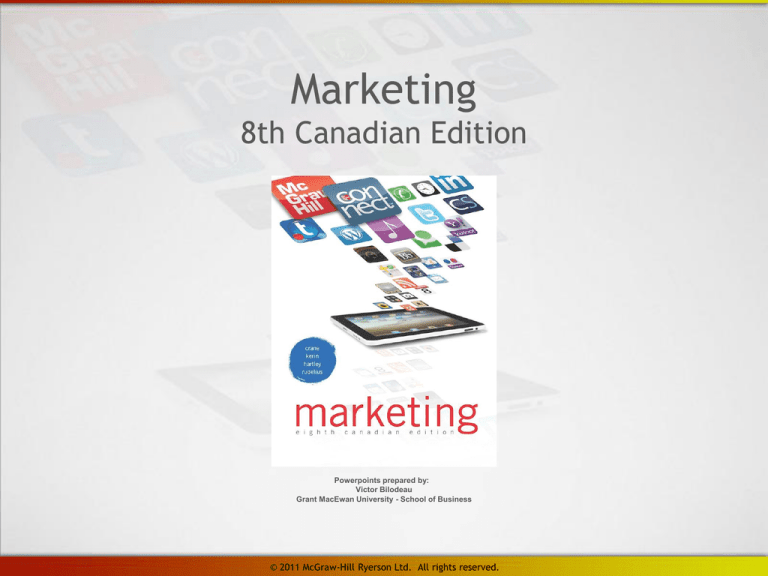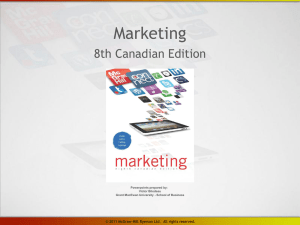
Marketing
8th Canadian Edition
Powerpoints prepared by:
Victor Bilodeau
Grant MacEwan University - School of Business
© 2011 McGraw-Hill Ryerson Ltd. All rights reserved.
Managing Products and
Brands
© 2011 McGraw-Hill Ryerson Ltd. All rights reserved.
Learning Objectives
After reading this chapter, you should be able to:
1.Explain the product life cycle.
2.Identify ways that marketing executives manage a product’s life
cycle.
3.Recognize the importance of branding and alternative branding
strategies.
4.Describe the role of packaging, labelling, and warranties in the
marketing of a product.
© 2011 McGraw-Hill Ryerson Ltd. All rights reserved.
© 2011 McGraw-Hill Ryerson Ltd. All rights reserved.
MANAGING PRODUCTS
AND BRANDS
‣ GATORADE: Satisfying the Unquenchable Thirst
‣ Gatorade has posted yearly sales gains over four decades
‣ It commands about 82 percent of the sports beverage market
in North America
© 2011 McGraw-Hill Ryerson Ltd. All rights reserved.
Gatorade’s success is
a direct result of
masterful and brand
management
strategies over 45
years.
© 2011 McGraw-Hill Ryerson Ltd. All rights reserved.
PRODUCT LIFE CYCLE
FIGURE 11-1
How stages of the
product life cycle
relate to a firm’s
marketing
objectives and
marketing mix
actions
© 2011 McGraw-Hill Ryerson Ltd. All rights reserved.
LO 1
PRODUCT LIFE CYCLE
‣ Introduction Stage
‣ Growth Stage
‣ Maturity Stage
‣ Decline Stage
‣ Deletion
‣ Harvesting
© 2011 McGraw-Hill Ryerson Ltd. All rights reserved.
LO 1
Space tourism and hydrogen cars are in the introductory
stage of the product life cycle.
© 2011 McGraw-Hill Ryerson Ltd. All rights reserved.
LO 1
Hybrid automobiles are in the growth stage of the product
life cycle.
© 2011 McGraw-Hill Ryerson Ltd. All rights reserved.
LO 1
PRODUCT LIFE CYCLE
‣ Some Dimensions of the Product Life Cycle
‣ Length of the Product Life Cycle
‣ Shape of the Product Life Cycle
‣ The Product Level:
‣ Product Class
‣ Product Form
‣ The Life Cycle and Consumers
© 2011 McGraw-Hill Ryerson Ltd. All rights reserved.
LO 1
FIGURE 11-2 Alternative product life cycles
© 2011 McGraw-Hill Ryerson Ltd. All rights reserved.
LO 1
FIGURE 11-3 Five categories and profiles of product
adopters
© 2011 McGraw-Hill Ryerson Ltd. All rights reserved.
LO 1
Learning Review
introductory stage of the
Advertising plays a major role in the ___________
product ______________
differentiation plays a major
product life cycle, and ________
role in maturity.
© 2011 McGraw-Hill Ryerson Ltd. All rights reserved.
LO 1
Learning Review
How do high-learning and low-learning products differ?
Answer:
High-learning products require significant education of the
consumer and consequently, there is an extended introductory
period. Low-learning products are the opposite of high-learning.
Sales begin rapidly for low-learning products because little
learning is required by the consumer.
© 2011 McGraw-Hill Ryerson Ltd. All rights reserved.
LO 1
Learning Review
What does the life cycle for a fashion product look like?
Answer:
The life cycle for a fashion product: it is introduced, declines,
and then returns again.
© 2011 McGraw-Hill Ryerson Ltd. All rights reserved.
LO 1
MANAGING THE
PRODUCT LIFE CYCLE
‣ Role of a Product Manager
‣ Modifying the Product
‣ Product modification
© 2011 McGraw-Hill Ryerson Ltd. All rights reserved.
LO 2
Using Marketing
Dashboards
Knowing Your CDI and
BDI
© 2011 McGraw-Hill Ryerson Ltd. All rights reserved.
LO 2
MANAGING THE
PRODUCT LIFE CYCLE
‣ Modifying the Market
‣ Market modification
‣ Finding New Users
‣ Increasing Use
‣ Creating New-Use Situation
© 2011 McGraw-Hill Ryerson Ltd. All rights reserved.
LO 2
MANAGING THE
PRODUCT LIFE CYCLE
‣ Repositioning the Product
‣ Reacting to a Competitor’s Position
‣ Reaching a New Market
‣ Catching a Rising Trend
‣ Changing the Value Offered
‣ Trading up
‣ Trading down
‣ Downsizing
© 2011 McGraw-Hill Ryerson Ltd. All rights reserved.
LO 2
Learning Review
How does a product manager help manage a product’s life cycle?
Answer:
A product manager helps manage a product's life cycle by: (1)
Developing and executing a marketing program for the product
line described in an annual marketing plan, (2) approving ad
copy, (3) media selection and, (4) package design. Product
managers plan, implement, and control the marketing strategy.
© 2011 McGraw-Hill Ryerson Ltd. All rights reserved.
LO 2
Learning Review
What does “creating new use situations” mean in managing a
product’s life cycle?
Answer:
Creating new-use situation means to find new uses for an
existing product. An example is when Mars, Inc. suggested that
M&M's candy be used as a replacement for chocolate chips in
baked goods.
© 2011 McGraw-Hill Ryerson Ltd. All rights reserved.
LO 2
Learning Review
Explain the difference between trading up and trading down in
repositioning.
Answer:
Trading up involves adding value to the product (or line) through
additional features or higher-quality materials. Trading down
involves reducing the number of features, quality, or price.
© 2011 McGraw-Hill Ryerson Ltd. All rights reserved.
LO 2
BRANDING AND
BRAND MANAGEMENT
‣ Branding
‣ Brand name
‣ Trade name
‣ Trademark
© 2011 McGraw-Hill Ryerson Ltd. All rights reserved.
LO 3
BRANDING AND
BRAND MANAGEMENT
‣ Brand Personality and Brand Equity
‣ Creating Brand Equity
‣ Valuing Brand Equity
‣ Brand Licensing
© 2011 McGraw-Hill Ryerson Ltd. All rights reserved.
LO 3
got2b ad
Can you describe
the personality
traits for this
brand?
© 2011 McGraw-Hill Ryerson Ltd. All rights reserved.
LO 3
Liz Claiborne Ad
Can you describe the
personality traits for
this brand?
© 2011 McGraw-Hill Ryerson Ltd. All rights reserved.
LO 3
FIGURE 11-4 Customer-based brand equity pyramid
© 2011 McGraw-Hill Ryerson Ltd. All rights reserved.
LO 3
Maple Leaf Sports &
Entertainment Ltd.
Focuses on building
bonds between fans
and its sports teams.
© 2011 McGraw-Hill Ryerson Ltd. All rights reserved.
LO 3
General Motors is the
worldwide leader in
licensed product sales
among automakers.
© 2011 McGraw-Hill Ryerson Ltd. All rights reserved.
LO 3
BRANDING AND
BRAND MANAGEMENT
‣ Picking a Good Brand Name
‣ Branding Strategies
‣ Multiproduct branding
‣ Multibranding
‣ Private Branding
‣ Cohort Brand Management
‣ Mixed Branding
© 2011 McGraw-Hill Ryerson Ltd. All rights reserved.
LO 3
FIGURE 11-5 Alternative branding strategies
© 2011 McGraw-Hill Ryerson Ltd. All rights reserved.
LO 3
Black & Decker uses a multibranding strategy to reach different
market segments.
© 2011 McGraw-Hill Ryerson Ltd. All rights reserved.
LO 3
PACKAGING AND LABELLING
‣ Creating Customer Value Through Packaging and
Labelling
‣ Communication Benefits
‣ Functional Benefits
‣ Perceptual Benefits
© 2011 McGraw-Hill Ryerson Ltd. All rights reserved.
LO 4
Marketing Matters
Creating Customer
Value through
Packaging: Pez Heads
Dispense
More Than Candy
© 2011 McGraw-Hill Ryerson Ltd. All rights reserved.
LO 4
PACKAGING AND LABELLING
Can you name this soft drink brand?
© 2011 McGraw-Hill Ryerson Ltd. All rights reserved.
LO 4
PACKAGING AND LABELLING
Which chip stacks up better?
© 2011 McGraw-Hill Ryerson Ltd. All rights reserved.
LO 4
The distinctive design of Celestial Seasonings tea boxes reinforces
the brand’s positioning as a New Age, natural herbal tea
© 2011 McGraw-Hill Ryerson Ltd. All rights reserved.
LO 4
PACKAGING AND LABELLING
‣ Contemporary Packaging and Labeling Challenges
‣ Connecting with Customers
‣ Environmental Concerns
‣ Health, Safety and Security Issues
‣ Cost Reduction
© 2011 McGraw-Hill Ryerson Ltd. All rights reserved.
LO 4
PRODUCT WARRANTY
‣ Express warranties
‣ Limited-coverage warranty
‣ Full warranty
‣ Implied warranties
© 2011 McGraw-Hill Ryerson Ltd. All rights reserved.
LO 4
Learning Review
How does a generic brand differ from a private brand?
Answer:
A generic brand is a no-brand product, which is an alternative
branding approach. A private brand is when a company
manufactures products but sells them under the brand name of a
wholesaler or retailer.
© 2011 McGraw-Hill Ryerson Ltd. All rights reserved.
LO 4
Learning Review
Explain the role of packaging in terms of perception.
Answer:
Packaging and labelling is the perception created in the
consumer's mind. A package can connote status, economy, and
product quality. Colour may also affect perceptions.
© 2011 McGraw-Hill Ryerson Ltd. All rights reserved.
LO 4
Learning Review
What is the difference between an expressed and an implied
warranty?
Answer:
An express warranty is a written statement of liability. An
implied warranty assigns responsibility for product deficiencies
to the manufacturer.
© 2011 McGraw-Hill Ryerson Ltd. All rights reserved.
LO 4
VIDEO CASE 11
Slow Cow
Slow Cow
© 2011 McGraw-Hill Ryerson Ltd. All rights reserved.
VIDEO CASE 11-1
Slow Cow
Where are energy and anti-energy drinks in terms of
the product lifecycle? What are the marketing
implications that relate to that position in the
lifecycle?
© 2011 McGraw-Hill Ryerson Ltd. All rights reserved.
VIDEO CASE 11-2
Slow Cow
If you are a marketing or brand manager for Slow Cow,
what should be your focus in terms of growing the
brand?
© 2011 McGraw-Hill Ryerson Ltd. All rights reserved.
VIDEO CASE 11-3
Slow Cow
Who would be a key target market for Slow Cow?
© 2011 McGraw-Hill Ryerson Ltd. All rights reserved.
VIDEO CASE 11-4
Slow Cow
What happens if an established energy drink company
decides to enter the anti-energy space? How does the
marketing game change for a company like Slow Cow?
© 2011 McGraw-Hill Ryerson Ltd. All rights reserved.
Product Life Cycle
‣ The four stages that a new product goes through in
the market place: introduction, growth, maturity,
and decline.
© 2011 McGraw-Hill Ryerson Ltd. All rights reserved.
Product Class
‣ The entire product category or industry.
© 2011 McGraw-Hill Ryerson Ltd. All rights reserved.
Product Form
‣ Variations of a product within the product class.
© 2011 McGraw-Hill Ryerson Ltd. All rights reserved.
Product Modification
‣ Altering a product’s characteristic, such as its quality,
performance, or appearance, to try to increase and
extend the product’s sales.
© 2011 McGraw-Hill Ryerson Ltd. All rights reserved.
Market Modification
‣ Strategy in which a company tries to find new
customers, increase a product’s use among existing
customers, or create new use situations.
© 2011 McGraw-Hill Ryerson Ltd. All rights reserved.
Trading Up
‣ Adding value to a product (or line) through additional
features or higher-quality materials.
© 2011 McGraw-Hill Ryerson Ltd. All rights reserved.
Trading Down
‣ Reducing the number of features, quality, or price.
© 2011 McGraw-Hill Ryerson Ltd. All rights reserved.
Downsizing
‣ Reducing the content of packages without changing
package size and maintaining or increasing the
package price.
© 2011 McGraw-Hill Ryerson Ltd. All rights reserved.
Branding
‣ Activity in which an organization uses a name, phrase,
design, or symbols, or combination of these to
identify its products and distinguish them from
competitors.
© 2011 McGraw-Hill Ryerson Ltd. All rights reserved.
Brand Name
‣ Any word, device (design, shape, sound, or colour), or
combination of these used to distinguish a seller’s
goods or services.
© 2011 McGraw-Hill Ryerson Ltd. All rights reserved.
Trade Name
‣ A commercial, legal name under which a company
does business.
© 2011 McGraw-Hill Ryerson Ltd. All rights reserved.
Trademark
‣ Identifies that a firm has legally registered its brand
name or trade name so the firm has its exclusive use.
© 2011 McGraw-Hill Ryerson Ltd. All rights reserved.
Brand Personality
‣ A set of human characteristics associated with a brand
name.
© 2011 McGraw-Hill Ryerson Ltd. All rights reserved.
Brand Equity
‣ The added value a given brand name gives to a
product beyond the functional benefits provided.
© 2011 McGraw-Hill Ryerson Ltd. All rights reserved.
Multiproduct Branding
‣ A company uses one name for all products; also called
blanket or family branding.
© 2011 McGraw-Hill Ryerson Ltd. All rights reserved.
Co-Branding
‣ The pairing of two brand names of two manufacturers
on a single product.
© 2011 McGraw-Hill Ryerson Ltd. All rights reserved.
Multibranding
‣ A manufacturer’s branding strategy giving each
product a distinct name.
© 2011 McGraw-Hill Ryerson Ltd. All rights reserved.
Private Branding
‣ When a company manufactures products but sells
them under the brand name of a wholesaler or
retailer (often called private labelling or reseller
branding).
© 2011 McGraw-Hill Ryerson Ltd. All rights reserved.
Mixed Branding
‣ A firm markets products under its own name and that
of a reseller because the segment attracted by the
reseller is different from its own market.
© 2011 McGraw-Hill Ryerson Ltd. All rights reserved.
Packaging
‣ Any container in which a product is offered for sale
and on which label information is communicated.
© 2011 McGraw-Hill Ryerson Ltd. All rights reserved.
Label
‣ An integral part of the package that typically
identifies the product or brand, who made it, where
and when it was made, how it is to be used, and
package contents and ingredients.
© 2011 McGraw-Hill Ryerson Ltd. All rights reserved.
Warranty
‣ A statement indicating the liability of the
manufacturer for product deficiencies.
© 2011 McGraw-Hill Ryerson Ltd. All rights reserved.
Cohort Brand Management
‣ The bundling of one company’s multiple brands into a
single marketing effort aimed at a common consumer
group.
© 2011 McGraw-Hill Ryerson Ltd. All rights reserved.
Brand Licensing
‣ A contractual agreement whereby a company allows
another firm to use its brand name, patent, trade
secret, or other property for a royalty or fee.
© 2011 McGraw-Hill Ryerson Ltd. All rights reserved.
Product Repositioning
‣ Changing the place an offering occupies in a
consumer’s mind relative to competitive products.
© 2011 McGraw-Hill Ryerson Ltd. All rights reserved.











